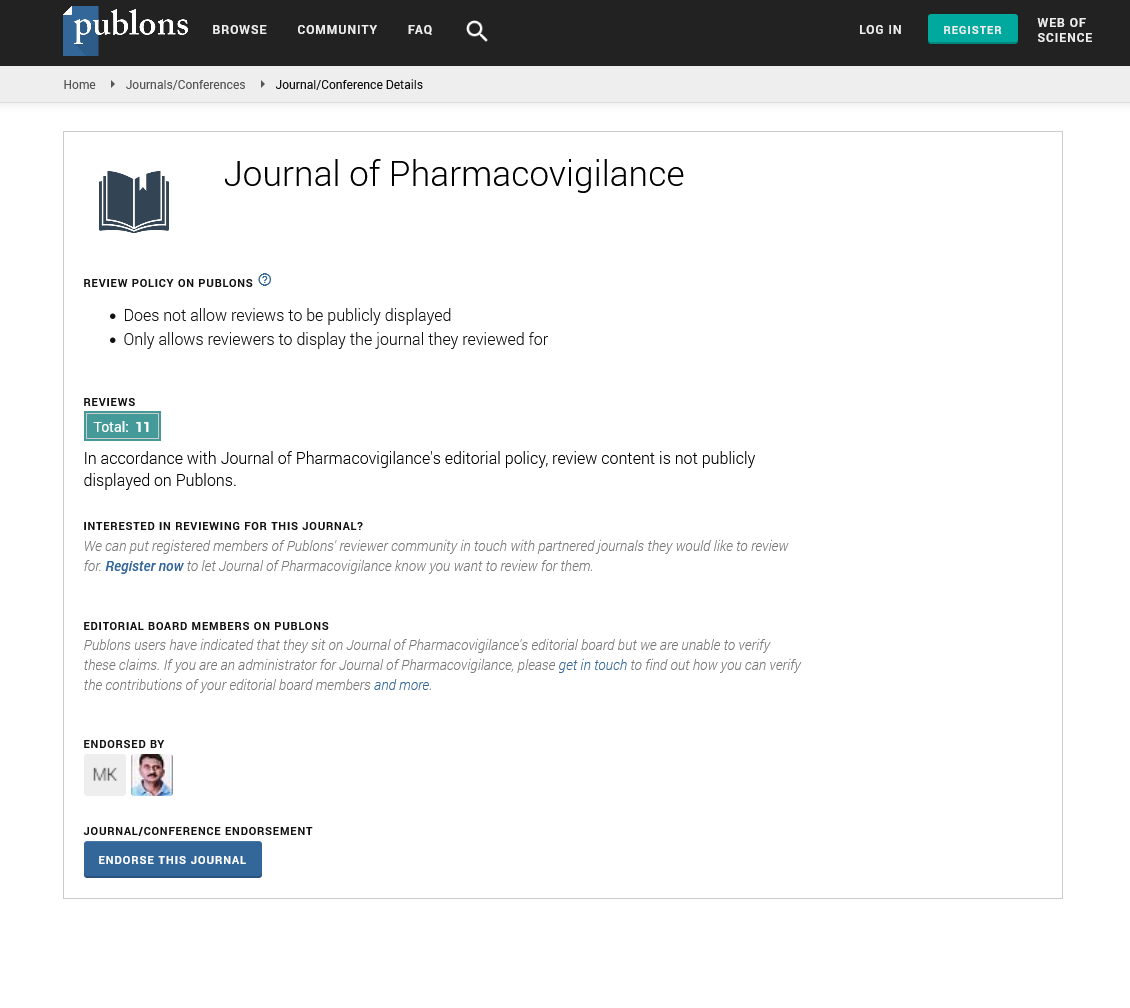Indexed In
- Open J Gate
- JournalTOCs
- The Global Impact Factor (GIF)
- RefSeek
- Hamdard University
- EBSCO A-Z
- OCLC- WorldCat
- Publons
- Euro Pub
- Google Scholar
Useful Links
Share This Page
Journal Flyer

Open Access Journals
- Agri and Aquaculture
- Biochemistry
- Bioinformatics & Systems Biology
- Business & Management
- Chemistry
- Clinical Sciences
- Engineering
- Food & Nutrition
- General Science
- Genetics & Molecular Biology
- Immunology & Microbiology
- Medical Sciences
- Neuroscience & Psychology
- Nursing & Health Care
- Pharmaceutical Sciences
Commentary - (2023) Volume 11, Issue 2
Economic Impact of Pharmacovigilance on Healthcare Systems
Qing Xie*Received: 01-Mar-2023, Manuscript No. JP-23-20589; Editor assigned: 03-Mar-2023, Pre QC No. JP-23-20589(PQ); Reviewed: 17-Mar-2023, QC No. JP-23-20589; Revised: 24-Mar-2023, Manuscript No. JP-23-20589(R); Published: 31-Mar-2023, DOI: 10.35248/2329-6887.23.11.421
About the Study
Patient safety and pharmacovigilance are two crucial components of healthcare that are intertwined. Patient safety is the art and science of preventing harm to patients while receiving medical care, whereas pharmacovigilance is the science of monitoring and evaluating the safety and efficacy of medications. To guarantee that patients receive safe and effective therapies, it is essential to understand how these two ideas relate to one another.
One of the most significant economic impacts of pharmacovigilance is the cost of Adverse Drug Reactions (ADRs). ADRs are a significant source of morbidity and mortality worldwide and can result in hospitalization, prolongation of hospital stay, and increased healthcare costs. In the United States of America alone, it has been estimated that the cost of ADRs ranges from $76.6 billion to $152 billion annually. Therefore, pharmacovigilance activities aimed at detecting and preventing ADRs can potentially save healthcare systems significant amounts of money.
Furthermore, pharmacovigilance has an impact on the pharmaceutical industry. It helps identify safety concerns early in the drug development process, reducing the likelihood of costly withdrawals from the market. Withdrawals can lead to significant losses for pharmaceutical companies, as they invest billions of dollars in the development of new drugs. By identifying safety concerns early, pharmacovigilance activities can help pharmaceutical companies avoid costly withdrawals and lawsuits, thereby saving them significant amounts of money.
In addition to reducing healthcare costs and preventing costly withdrawals, pharmacovigilance can also have a positive impact on healthcare systems by promoting the rational use of medicines. Rational use of medicines refers to the use of medications in a way that maximizes their therapeutic benefits while minimizing the risks of adverse effects. Pharmacovigilance activities can help identify inappropriate prescribing and medication errors, leading to improved prescribing practices, decreased medication-related morbidity and mortality, and ultimately, cost savings.
Moreover, pharmacovigilance can have a positive impact on healthcare systems by improving public trust in healthcare providers and pharmaceutical companies. By detecting and addressing safety concerns promptly, pharmacovigilance activities can help ensure that patients have access to safe and effective medications. This, in turn, can lead to increased patient satisfaction and trust in healthcare providers and pharmaceutical companies, which can have positive economic impacts, such as increased medication adherence and decreased healthcare costs due to avoidable adverse events.
Despite the numerous economic benefits of pharmacovigilance, there are also costs associated with its implementation. The costs of pharmacovigilance activities can be divided into direct costs, such as the cost of hiring and training pharmacovigilance staff, and indirect costs, such as the cost of lost productivity due to adverse events. However, it is important to note that the costs of pharmacovigilance are minimal compared to the potential economic benefits that can be achieved through its implementation.
Furthermore, the economic impact of pharmacovigilance can vary depending on the level of development of the healthcare system. In low- and middle-income countries, where healthcare systems are often under-resourced, pharmacovigilance activities may face significant challenges. These challenges include a lack of trained personnel, inadequate infrastructure, and limited access to healthcare data. However, pharmacovigilance activities can still have a positive impact on healthcare systems in these countries by reducing healthcare costs, improving medication safety, and promoting the rational use of medicines.
In conclusion, pharmacovigilance is a critical component of healthcare systems worldwide that plays an essential role in ensuring patient safety, promoting the rational use of medicines, and improving public trust in healthcare providers and pharmaceutical companies. The economic impact of pharmacovigilance on healthcare systems is significant and the potential economic benefits far outweigh the costs of its implementation. Therefore, it is essential for healthcare systems to invest in pharmacovigilance activities to improve medication safety, reduce healthcare costs, and promote the rational use of medicines. Additionally, further research is needed to understand the economic impact of pharmacovigilance in low and middle-income countries and to identify ways to overcome the challenges faced by these healthcare systems. By doing so, we can ensure that pharmacovigilance activities continue to play a critical role in promoting patient safety and improving healthcare outcomes worldwide.
Citation: Xie Q (2023) Economic Impact of Pharmacovigilance on Healthcare Systems. J Pharmacovigil. 11:421.
Copyright: © 2023 Xie Q. This is an open-access article distributed under the terms of the Creative Commons Attribution License, which permits unrestricted use, distribution, and reproduction in any medium, provided the original author and source are credited.

